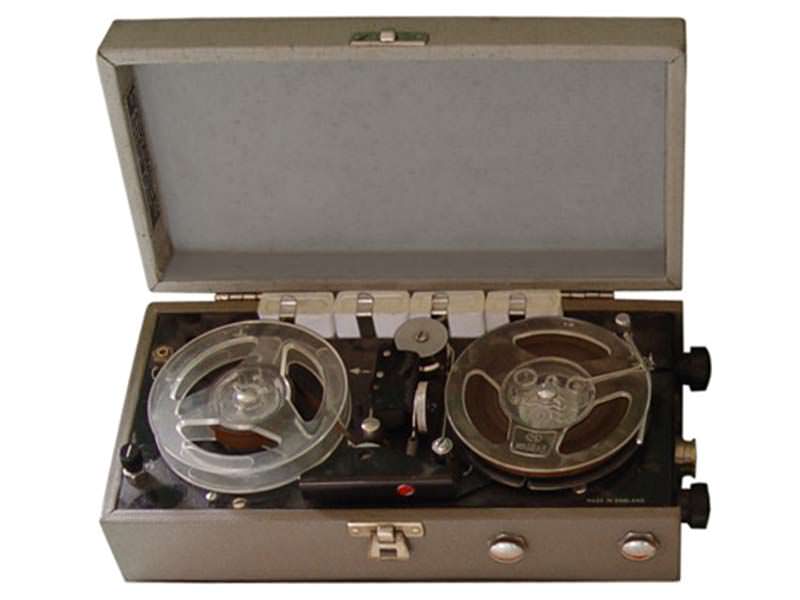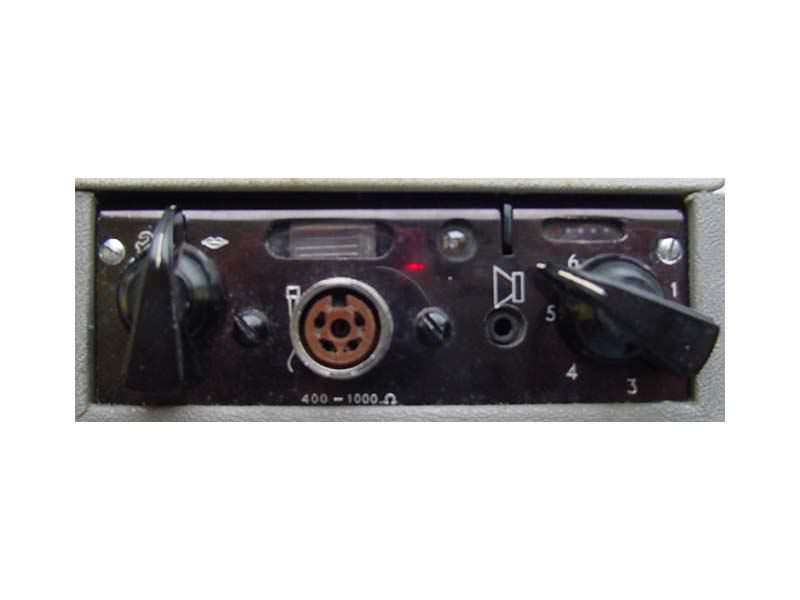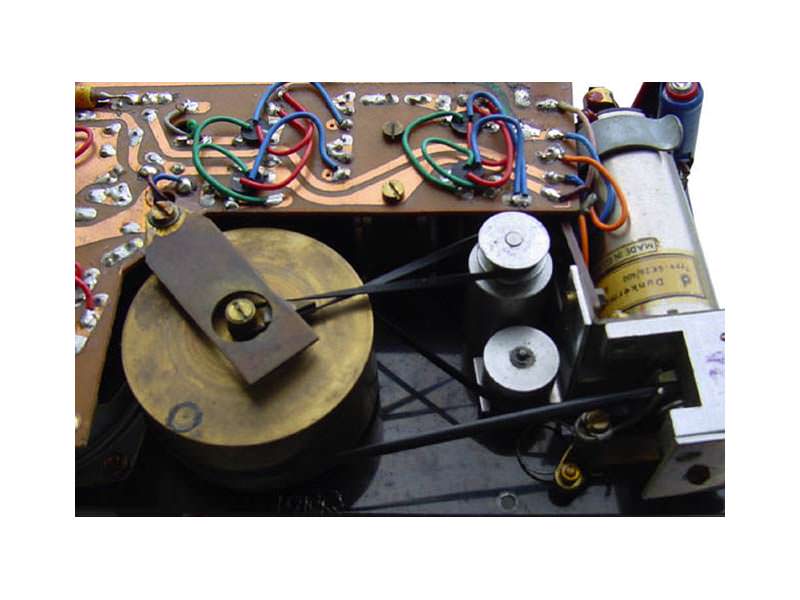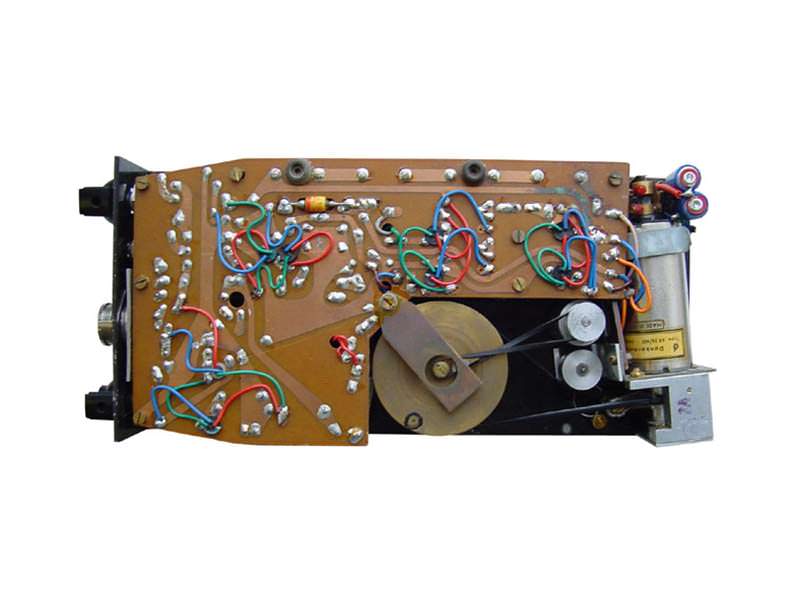Technical Details
Brand: Fi-Cord
Model:1 A
Category:Vintage
Application:Consumer
Electronics:Tube
Equalization:IEC
Country of Manufacture:United Kingdom
Release dates:1958 - 1961
Tracks:1/2 Rec/PB
Speeds: 1 7/8, 7 1/2
Max Reel Size("): 7"
Number of heads: 2
Head Composition: Permalloy
Head Configuration: Stereo
Auto Reverse?:No
Voltage(s): Multi
Frequency Response:(all 3 dB): 7½ ips: 50Hz - 12kHz on tape, overall 50 - 10kHz
Wow and Flutter:0.4% at 7½ ips
Sound quality rating:5 / 10
Long-term reliability rating: 5/ 10
Additional Details
Description
Made in Yorkshire, UK under license from the Swiss company Quellet-Stellavox, the battery-operated
Fi-Cord 1-A weighed only 4½ lbs (2 kg) and had the unusual tape speed combination of 7½ and 1 7/8
ips.
Powered by four small rechargeable batteries, the Fi-Cord had an inbuilt monitor speaker but could be played through an external amplifier via the ‘hi-fi’ output socket. Additional monitoring options were via an acoustic earphone or stethophone plugged into the main panel.
A dynamic microphone with start/stop motor switch was supplied with the option available to connect a high quality studio microphone to the 400/1000 ohm impedance input socket. Battery life (without recharging) gave a recording time of 1½ – 2 hours at 7½ ips or 3 – 3½ hours at 1 7/8 ips.
Additional Info
Fi-Cord 1-A – From Tape Recording Magazine, June 1959
FOR many years until recently, the only available portable battery machine was the EM1 L2. The Boosey & Hawkes “Recorder” could never compare in performance with the E.M.I. machine; for all portable recordings, one had to use an L2, though it had its shortcomings.
The new Fi-Cord transistor portable compares very favourably with this firm’s earlier model – especially in price.
To operate the old machine economically, it was necessary to buy an expensive accumulator pack, whereas now rechargeable miniature batteries are included in the price, in addition to the easily portable mains battery-charger unit.
A versatile machine
I consider myself that the new Fi-Cord is in many ways more versatile than the L2. Having made numerous recordings outside and indoors, I can only fault the machine in one respect, which will be mentioned later. The Fi-Cord is made under licence from a Swiss firm, and measures approx. 5 in. x 3 in. x 9 in. Thus it will fit easily into any large handbag or small attaché case.
I will first mention some details of the machine itself. It records half-track at 7½ ips for good speech quality or amateur music recording and at 1 78 ips for documentation speech recording. It will, of course, be realised that the slower speed gives a poor frequency response, but the speech remains always perfectly intelligible.
The capstan motor runs at these two speeds and takes its current supply from the main accumulators. The tape tension on the take-up spool is controlled from the capstan itself, which drives this same spool, and the supply spool is held in continuous back-tension by a metal rod applying spring pressure against the tape on the spool. A fly-wheel and guides are incorporated to reduce wow and flutter as low as is possible, consistent with keeping the size of the machine relatively small.
Internal speaker
An internal loudspeaker allows tapes to be played back immediately after recording. A 3½ -in. spool of tape, using double-play tape, allowing for both tracks, will last 1¼ hours. The machine will operate from the internal batteries between one and two hours’ continuous running at the fast sped, and about three hours at the slower speed, the main consumption of the machine being the current taken by the motor itself. As the exchangeable batteries are relatively cheap for the service that they give, it is quite possible to take a spare set and to change batteries in a matter of a few seconds, as they are just clipped in behind the spools themselves.
If the lid is closed while the recording is being made, it automatically mutes the internal speaker which, however, remains in operation when the machine is recording normally. The inputs are between 300 and 1,000 ohms for microphone, and there is a higher impedance input for taking the output from a portable radio set. There is also an output at low impedance to drive an external amplifier, if desired.
The tape modulation is controlled by an ordinary gain control, which is set by watching a miniature line magic-eye indicator; the maximum level of recording occurs when the line changes into a barely discernible dot. One should never, while recording, allow the magic-eye always to be “blacked out”: in fact, the blacking out should occur only on extreme peaks.
It is essential to modulate the tape as high as possible, however, because of the performance of the transistors which are, I am afraid, a little noisy. I have tried out a number of these models, and some have a tendency to be very noisy on recording, putting a sort of background “mush” on the tape if the recording gain control is turned beyond a certain point.
It is, therefore, advisable to use a microphone with as high an output, at the input impedance suggested (600 ohms), as is possible. Two microphones recommended are the Lustraphone full-vision microphone, which is wound especially with an impedance of 600 ohms, and the Reslo ribbon microphone, fitted with special baffle internally, having an impedance of about 1,000 ohms. The microphone supplied was nowhere near the standard of these two microphones.
The machine sent for review was taken round on the underground railway and on to main railway stations to record outside sound effects, and the sounds obtained were quite realistic when played back at the studio on a Simon recorder at 7½ ips. It demonstrated how little one normally notices the amount of noise one encounters on the way to work! This recorder showed up the many weird noises trains make when standing still or starting up. I have now discovered for example, that the pneumatic drill-type noise made by many Metropolitan underground trains, is due to a compressor, which allows the train to have good brakes.
But to get back to the Fi-Cord; the machine is supplied with shoulder straps and can be very conveniently switched on and off without anybody knowing it is recording. I must mention, however, that when the machine arrived the strap was not connected to it and I had extreme difficulty in fixing the straps to the knobs projecting from the chassis.
Because I am rather tall, I had to extend the strap, whereupon one of the buttons joining the straps together came off! Perhaps something could be done about this by the manufacturers.
I realise I may have been a little critical of this machine. Let me be fair: for only 59 guineas, this complete machine, equipped with microphone (on which there is a switch starting and stopping the recorder), four miniature accumulators which fit inside the machine, and the complete battery charger, I feel this compares very favourably with any other available machine recording at 7½ ips. This recorder is suggested for those who are not expecting a professional or even semi-professional machine, but who want a good, reliable and robust machine to have fun with – anywhere from the top deck of a bus to the inside of a cave at the seaside. I do recommend it, if the purchaser fully accepts the limitations.
I would suggest, however, that the British manufacturers of this machine should test to a specific standard every machine sent out. Although their own workmanship may be good, transistors still may not be completely reliable when they come off the factory mass-production line.
Transistor complement: 7 General Electric types GET 3 and GET 4 / Inputs: 400 / 1kohm studio-type microphone, 0.4mV to fully load tape / Outputs: hi-fi output and earphone / Speaker(s): internal monitor-type / Dimensions: 9½ x 5 x 2½” (244.5 x 127 x 69.5 mm) / Weight: 4½ lbs (2 kg) / half-track mono





